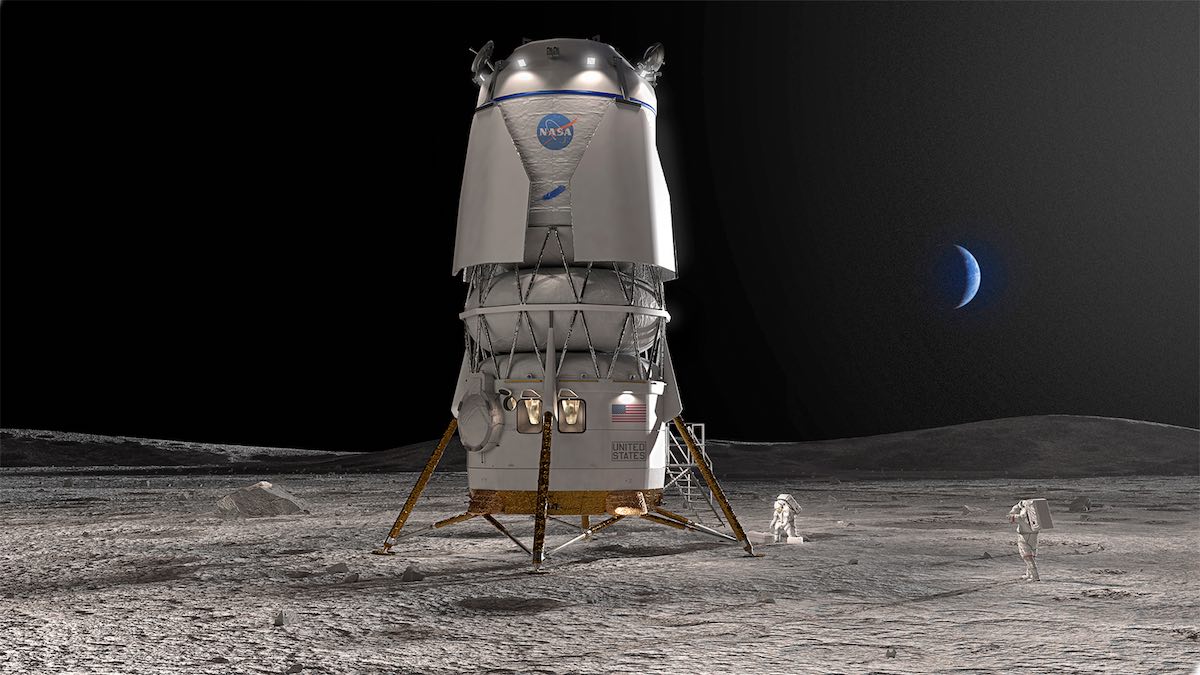Space News & Blog Articles
NASA awards Blue Origin $3.4 billion Artemis moon lander contract
STORY WRITTEN FOR CBS NEWS & USED WITH PERMISSION
 Artist’s concept of Blue Origin’s 52-foot-tall (16-meter) Blue Moon lander. Credit: Blue Origin
Artist’s concept of Blue Origin’s 52-foot-tall (16-meter) Blue Moon lander. Credit: Blue Origin
Blue Origin, the rocket company owned by Amazon-founder Jeff Bezos, has won a $3.4 billion NASA contract to build an Artemis lunar lander that will provide a downstream alternative to the Starship variant already being developed by SpaceX, the agency announced Friday.
“We are going to the Moon! Honored to be on this journey with @nasa to land astronauts on the Moon — this time to stay,” Bezos said in an Instagram post.
John Couluris, Blue Origin vice president for lunar transportation, said the company expects to chip in “well north” of the contract value to fully develop its “Blue Moon” lander, pushing the total cost of the project to around $7 billion. The first piloted landing, part of the fifth Artemis mission, is expected in the 2029 timeframe.
“On behalf of Blue Origin and the national team, I want to thank NASA personally,” Couluris said. “We’re very honored and humbled to be part of this incredible experience. We’re looking forward to participating on Artemis 5, and we’re looking forward to working together.”
Blue Origin’s national team includes Lockheed Martin, which will provide a refueling and servicing spacecraft; Boeing, which will supply docking technology; Draper, supplying guidance, navigation and simulator technology; Astrobotic Technology, with expertise in payload accommodations; and Honeybee Robotics to handle cargo delivery systems.
The contract requires Blue Origin to fly an unpiloted dress-rehearsal landing before astronauts float aboard and descend to the lunar surface during the Artemis 5 mission. That flight will follow the initial Artemis 3 moon landing, using SpaceX’s lander, in the 2025-26 timeframe.
“We want more competition,” said NASA Administrator Bill Nelson. “We want two landers. That’s better. It means that you have reliability, you have backups. It benefits NASA. It benefits the American people. … It helps NASA share the risk, the technical risk, and the financial risk to enable, at the end of the day, mission success.”
The contract award caps a long, occasionally contentious struggle by Blue Origin to join the Artemis program. The company and another team lost out to SpaceX in 2021 when NASA awarded Elon Musk’s company a $2.9 billion contract to build a variant of its Starship rocket for the initial Artemis 3 moon landing.
Blue Origin protested the original award, delaying work on the Starship lander, but the company’s efforts were unsuccessful. Last November, SpaceX won an additional $1.1 billion to develop an upgraded version of its lander, one capable of longer stays to support “sustained” exploration. It’s not yet clear when that variant might fly.
The fully reusable Blue Moon lander will stand about 52 feet tall, fitting inside the 23-foot-wide nose cone of Blue Origin’s New Glenn rocket. The spacecraft’s crew compartment, capable of supporting four astronauts for up to 30 days, will sit atop four landing legs and rocket motors. A short stairway will provide easy access to the surface.
A squat liquid oxygen tank and larger hydrogen tank will be positioned atop the crew cabin, along with radiator panels and solar arrays. A port on the side of the crew compartment will enable rovers to dock with the lander, allowing astronauts to move from one vehicle to another without having to first venture outside.
The Blue Moon architecture calls for a New Glenn rocket to launch the lander into the elliptical “near rectilinear halo orbit,” or NRHO, that NASA is using for its planned Gateway lunar space station.
Lockheed Martin’s “cis-lunar transporter” spacecraft will carry propellants from low-Earth orbit to the moon where it will link up with the Blue Moon lander in the NRHO, fueling it for its eventual descent to the surface.
The lander will dock at the Gateway station where four Artemis astronauts, launched aboard an Orion capsule by NASA’s Space Launch System rocket, will be waiting. From there, the Blue Moon will carry the crew to the lunar surface, bringing them back up to Gateway and Orion after a stay of up to 30 days.
The NASA contract calls for an unpiloted dress rehearsal descent from Gateway and landing near the south pole before astronauts float aboard during the Artemis 5 mission for the first piloted landing. But Blue Origin plans multiple test flights ahead of the rehearsal using less capable versions of the lander to test specific systems.
The Blue Moon can be configured in two versions.
“The first is a crew configuration that will be able to land four astronauts anywhere on the surface of the moon, day or night,” Couluris said. “That will be the first mission that we fly as part of Artemis 5.
“This vehicle also can be configured for a cargo landing mission able to carry up to 20 metric tons in a round trip … or 30 metric tons to the surface to form the foundation of habitats and other permanent infrastructure.”
In between surface sorties, the lander can simply remain in the near rectilinear halo orbit at or near Gateway while awaiting follow-on missions. Bezos and Couluris said Blue Origin is already working on technologies enabling long-term storage of the ultra-cold liquid oxygen and hydrogen propellants.
Having two independent landers from different providers, NASA said in a statement, “will increase competition, reduce costs to taxpayers, support a regular cadence of lunar landings, further invest in the lunar economy and help NASA achieve its goals on and around the moon in preparation for future astronaut missions to Mars.”
When you subscribe to the SpaceZE News Feed, we will send you an e-mail when there are new updates on the site so you wouldn't miss them.

